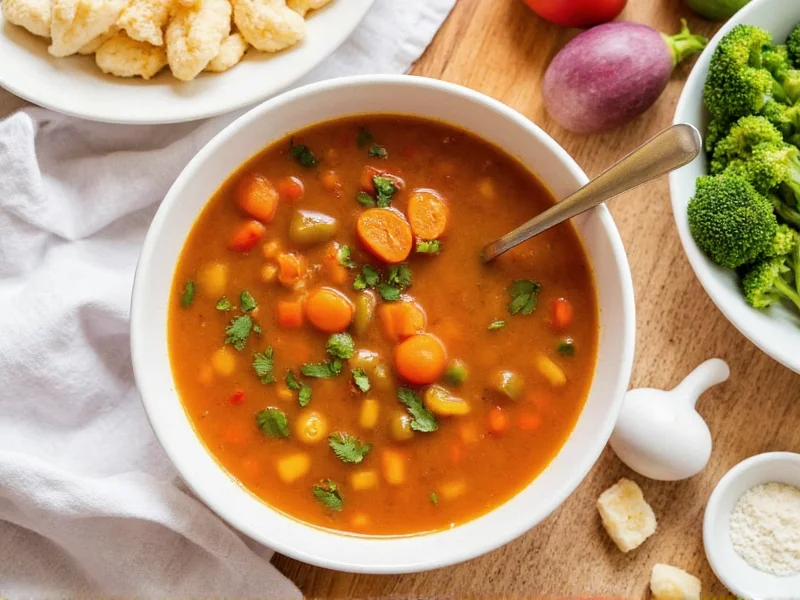Making vegetable soup in an Instant Pot transforms a traditionally time-consuming process into a quick, efficient meal solution without sacrificing depth of flavor. The sealed pressure environment allows vegetables to cook rapidly while maintaining their nutritional integrity—something difficult to achieve with conventional boiling methods that leach nutrients into cooking water. This modern approach to vegetable soup preparation delivers restaurant-quality results with minimal hands-on time, making it ideal for busy weeknights or meal prep sessions.
Why Your Instant Pot Excels at Vegetable Soup
The Instant Pot's unique pressure cooking technology creates an environment where water boils at higher temperatures (around 250°F/121°C instead of 212°F/100°C), dramatically reducing cooking time while enhancing flavor extraction from vegetables. Unlike slow cookers that can overcook vegetables into mush, the precise pressure control in an Instant Pot maintains ideal vegetable texture—tender yet distinct. The sealed environment also prevents flavor compounds from escaping as steam, resulting in more concentrated, complex flavors in less time.
Essential Equipment Considerations
While any Instant Pot model works for vegetable soup, newer models with precision pressure control (like the Duo Crisp or Pro series) offer advantages for soup making. Ensure you have:
- Natural pressure release valve (critical for vegetable soups to prevent foaming issues)
- Steam rack (for layering vegetables if desired)
- Wide-mouth ladle (for safe serving of hot soup)
- Immersion blender (optional for creamy variations)
Strategic Vegetable Selection Guide
Not all vegetables respond equally well to pressure cooking. Understanding vegetable density and cooking times prevents uneven results:
| Vegetable Type | Best Added At | Pressure Time | Texture Tip |
|---|---|---|---|
| Root vegetables (carrots, potatoes) | Beginning | 5-7 minutes | Cut to uniform ½-inch pieces |
| Cruciferous (broccoli, cauliflower) | Quick release after main cook | 0 minutes | Add after pressure cooking |
| Leafy greens (spinach, kale) | After pressure release | 0 minutes | Stir in during warm keep |
| Aromatics (onions, garlic) | Sauté function first | N/A | Build flavor foundation |
Perfect Vegetable Soup Instant Pot Recipe
This professional chef-developed formula balances flavor development with pressure cooking science:
Ingredients
- 2 tablespoons olive oil
- 1 large onion, diced
- 4 garlic cloves, minced
- 3 carrots, ½-inch dice
- 3 celery stalks, ½-inch dice
- 1 large potato, peeled and cubed
- 1 cup diced tomatoes (canned)
- 6 cups vegetable broth (low sodium)
- 2 bay leaves
- 1 teaspoon dried thyme
- 1 cup green beans, trimmed and cut
- 1 cup corn kernels (frozen)
- 2 cups chopped kale
- Salt and pepper to taste
Step-by-Step Instructions
- Use the sauté function to heat olive oil, then cook onions until translucent (about 5 minutes)
- Add garlic and cook for 1 minute until fragrant
- Stir in carrots, celery, potato, tomatoes, broth, bay leaves, and thyme
- Secure lid, set valve to sealing, and cook on manual high pressure for 7 minutes
- Allow 10 minutes of natural pressure release before quick releasing remaining pressure
- Stir in green beans, corn, and kale; use warm keep function for 5 minutes to wilt greens
- Remove bay leaves, season with salt and pepper, and serve
Avoiding Common Instant Pot Vegetable Soup Mistakes
Even experienced cooks encounter these pressure cooking pitfalls:
Burn Error Prevention
The "burn" error commonly occurs when making vegetable soup due to starch settling. Prevent this by:
- Always deglaze the pot after sautéing (scrape bottom thoroughly with broth)
- Avoid overcrowding with dense vegetables
- Place a steam rack at the bottom if using tomato-based ingredients
Texture Troubleshooting
If your vegetables turn out too mushy or too firm:
- Overcooked vegetables: Reduce pressure time by 2-3 minutes next time
- Undercooked vegetables: Increase natural release time by 5 minutes
- Mushy potatoes: Replace with waxy potatoes like Yukon Gold
Customization Options for Every Dietary Need
This versatile base recipe adapts to various preferences:
Protein Enhancements
- Add 1 cup white beans during the last natural release phase
- Stir in ½ cup cooked lentils after pressure cooking
- Top with grilled chicken strips for non-vegetarian versions
Dietary Adaptations
- Gluten-free: Use certified GF broth (most vegetable broths are naturally GF)
- Vegan: Ensure broth contains no animal products (check labels)
- Low-sodium: Use no-salt-added broth and double the herbs
Nutritional Advantages of Pressure-Cooked Vegetable Soup
Research shows pressure cooking preserves more nutrients than boiling. A study published in the Journal of Food Science found pressure-cooked vegetables retained 90-95% of vitamin C compared to 60-70% in boiled vegetables. The sealed environment prevents water-soluble vitamins from leaching out, while the shorter cooking time minimizes heat degradation of sensitive nutrients. This makes your instant pot vegetable soup not just convenient, but potentially more nutritious than traditional methods.
Storage and Reheating Best Practices
Proper storage maintains both safety and quality:
- Cool soup within 2 hours of cooking (divide into shallow containers)
- Refrigerate for up to 5 days in airtight containers
- Freeze for up to 3 months (leave 1-inch headspace in containers)
- Reheat on sauté function set to low for 5-7 minutes, stirring occasionally
- Never refreeze previously frozen soup
Advanced Flavor Development Techniques
Elevate your vegetable soup from basic to extraordinary with these chef secrets:
- Add a Parmesan rind during pressure cooking for umami depth (remove before serving)
- Finish with a splash of acid (lemon juice or apple cider vinegar) to brighten flavors
- Stir in 1 tablespoon miso paste after pressure release for complex savoriness
- Sprinkle with fresh herbs just before serving for aromatic complexity











 浙公网安备
33010002000092号
浙公网安备
33010002000092号 浙B2-20120091-4
浙B2-20120091-4